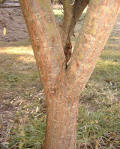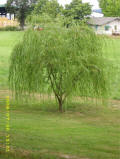|
Home Page
About Us
Our
Business
Our
History
Virtual
Farm Tour
Interesting Plants
What's in Bloom
Favorite
Links
Contact
Us





 | |
Welcome to Dunton
Family Farms
Since 1909
|
 |
George Washington's Weeping Willow
on the Dunton Farm |
 In
2001 while visiting the new house of some friends near Beavercreek, Oregon,
a large weeping willow tree caught the eye of our then eleven year old son John. He had always loved willows and we asked about it. In
2001 while visiting the new house of some friends near Beavercreek, Oregon,
a large weeping willow tree caught the eye of our then eleven year old son John. He had always loved willows and we asked about it.
 Our
friends said that when they were buying the house, the woman that owned it
made a point of telling them her story vacationing on the east coast in the 1950s or 1960s
and visiting the final resting place of George Washington. Our
friends said that when they were buying the house, the woman that owned it
made a point of telling them her story vacationing on the east coast in the 1950s or 1960s
and visiting the final resting place of George Washington.
 On
the site at Mt. Vernon was a magnificent weeping willow tree. She
had to have one for herself so she snipped a twig, babied it for the rest
of the trip, and upon arriving home, got it growing and ultimately
nurtured into the huge specimen tree we were marveling at. On
the site at Mt. Vernon was a magnificent weeping willow tree. She
had to have one for herself so she snipped a twig, babied it for the rest
of the trip, and upon arriving home, got it growing and ultimately
nurtured into the huge specimen tree we were marveling at.
 So, like this woman on vacation, we had to have that
connection to the history of our nation on our family farm. So, like this woman on vacation, we had to have that
connection to the history of our nation on our family farm.
We got a
twig to root, nurtured it in a pot for a year, and planted in on the side
of our hill near where we intend to
install ponds.
We have started several new clones for friends to ensure that the genetics survive.
A History of the George Washington Grave Site Weeping
Willow Tree
According to history, the lineage of the tree dates back
to the Island of St. Helena and the final resting place of Napoleon
Bonaparte. In 1821, he was buried there
"in a lonely spot near a spring shaded by two weeping willows."
In 1835, clippings from the trees were presented to the U.S. from France
and they were planted around the grave of George Washington at Mt. Vernon.
I contacted Mt. Vernon and chatted with the person in charge of the grounds and he informed me that there is no longer a willow tree near the grave.
References to George Washington's Gravesite and Willow Trees:
-
Napoleon died on 5 May 1821. He was dressed in his favorite uniform and
covered with the cloak he wore at the battle of Marengo. He was buried
"in a lonely spot near a spring shaded by two weeping willows."
In 1835, a French naval officer took cuttings from the grave of Napoleon
and they were presented as a gift of the French nation to the United
States. The cuttings were planted at Mount Vernon next to the grave of
George Washington, where they thrived.
Following the end of the Civil War, an officer who was preparing to move
west, brought similar clippings from the now flourishing willows at
Mount Vernon, to Washington Territory. They were planted at the
officerís new home on the hill above downtown Seattle. They thrived in
this climate as well.
In 1962, the State of Washington decided Interstate 5 should be built
across the property of the now deceased Civil War veteran. His son,
James Vernon Metcalfe, had grown up with the story of the willow tree in
the yard and he felt it was worth saving from the bulldozers of the
freeway project. He convinced the City of Seattle to take cuttings and
plant them in appropriate locations to maintain the lineage of the St.
Helena willow.
Metcalfe also happened to be the historian of the Pioneer Association of
Washington (state) and he arranged for the City arborist to place some cuttings
of the willow on the property at Pioneer Hall. Once again, a few feet
from the shore of Lake Washington, the tree thrived. For the past 40
years it has graced the building that the Fiske Library now calls home.
It may be far-fetched to trace the story of
a tree for 180 years, in four widely separated physical locations, and
call it a "genealogy" but the parallel is not too far removed from what
we seek whenever we trace the peripatetic path of our predecessors. -- Source
link. [Local Copy]
James Vernon Metcalfe (of Seattle) noted in the 1967 biography of his father:
James Bard Metcalfe
made a trip to Washington, D. C. and visited the grave of George Washington at Mt. Vernon, MD. He obtained permission from the guard to take a generous slip from the weeping willow trees surrounding the grave of Washington. The parents of these trees had been presented to the officers of the U. S. S. Saranac as an international compliment to the United States from the French Government in 1830. Those slips were from the weeping willow trees surrounding the grave of Napoleon on the Isle of St. Helena off the coast of South Africa. Napoleon had been buried there in 1820 where he remained for 17 years before his removal to the monument of des Invalides in Paris.
Gen. Metcalfe brought the maturing slip to Seattle in 1883 and planted it at his home at Ninth and Main Streets [now under the I-5 freeway] where it grew to a very stately tree. In 1907 it was offered to the Alaska Yukon Pacific Exposition but it was considered too large to move. The tree was destroyed by the Jackson Street re-grade but slips had been planted at the same spot behind the former Hotel Tacoma where they flourish to this day [in 1967]. One tree drapes close to the Freeway between Jackson and Main Streets. The Seattle Housing Authority has acquired the land where the trees are growing and expects to preserve them in a park in 1968.
Biographical Note: James Vernon was the historian for the Pioneer Association of the State of Washington from 1951-69 and served as the president from 1969-72. --
Source Link.
 Napoleonís
willows -
It is said that all the weeping willow trees in Australia are descended
from cuttings taken from trees that surround Napoleonís grave on St.
Helena, brought by British people when their ships stopped at the island
en route. Napoleonís
willows -
It is said that all the weeping willow trees in Australia are descended
from cuttings taken from trees that surround Napoleonís grave on St.
Helena, brought by British people when their ships stopped at the island
en route.The willow is by
tradition a sad tree. People who have lost their love place mourning
garlands on willow branches and exiles hung their harps on them. "She is
in her willows" implies the mourning of a female for her lost mate. -- Source link. Painting source link.
July 4, 1926 - The 150th Anniversary of the
signing of the Declaration of Independence takes place (4-5 July)
throughout the nation; President Coolidge plants a willow tree (the
same kind of tree near the grave of George Washington at Mount Vernon)
on the South Jersey exposition grounds in connection with the opening of
the Delaware River bridge). Source link.
"Memorial for George Washington"; Watercolor by Samuel Folwell; circa 1800
Free Masonry Litho - "Disturb not his Slumbers let Washington
sleep Neath the Boughs of the Willow that over him weep, His Arm
is unnerved, but his Deeds remain bright, As the Stars in the dark
vaulted Heavan at Night. Oh! wake not the Hero, his Battles are over,
Let him rest undisturbed on the Potomacs fair Shore, On the Rivers green
Borders, so flowery drest, With the Hearts he loved fondly, let
Washington rest."
Other examples of "Washington Willow Tree" clones:
- The yard of the late Jane Barfoot-Hodde in Olga, Washington located
across the street from the Olga Community Clubhouse.
- Kendall Family Farm, Minnesota
-
Other references of willow trees in association with George
Washington:
|
|
|
Copyright © 1996 - 2022 by Dunton Family Farm |
|